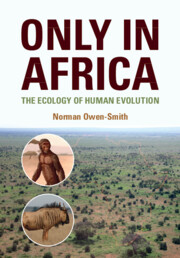Book contents
- Only in Africa
- Only in Africa
- Copyright page
- Dedication
- Contents
- Foreword
- Preface
- Abbreviations
- Part I The Physical Cradle: Land Forms, Geology, Climate, Hydrology and Soils
- Chapter 1 High Africa: Eroding Surfaces
- Chapter 2 Climate: Rainfall Seasonality
- Chapter 3 Water in Rivers, Lakes and Wetlands
- Chapter 4 Bedrock Geology: Volcanic Influences
- Chapter 5 Soils: Foundations of Fertility
- Part I Synthesis: Structure of the Physical Cradle
- Part II The Savanna Garden: Grassy Vegetation and Plant Dynamics
- Part III The Big Mammal Menagerie: Herbivores, Carnivores and Their Ecosystem Impacts
- Part IV Evolutionary Transitions: From Primate Ancestors to Modern Humans
- Appendix Scientific Names of Extant Animal and Plant Species Mentioned in the Book Chapters (Ecologically Conservative with Regard to Species Recognition)
- Index
- References
Chapter 5 - Soils: Foundations of Fertility
from Part I - The Physical Cradle: Land Forms, Geology, Climate, Hydrology and Soils
Published online by Cambridge University Press: 09 September 2021
- Only in Africa
- Only in Africa
- Copyright page
- Dedication
- Contents
- Foreword
- Preface
- Abbreviations
- Part I The Physical Cradle: Land Forms, Geology, Climate, Hydrology and Soils
- Chapter 1 High Africa: Eroding Surfaces
- Chapter 2 Climate: Rainfall Seasonality
- Chapter 3 Water in Rivers, Lakes and Wetlands
- Chapter 4 Bedrock Geology: Volcanic Influences
- Chapter 5 Soils: Foundations of Fertility
- Part I Synthesis: Structure of the Physical Cradle
- Part II The Savanna Garden: Grassy Vegetation and Plant Dynamics
- Part III The Big Mammal Menagerie: Herbivores, Carnivores and Their Ecosystem Impacts
- Part IV Evolutionary Transitions: From Primate Ancestors to Modern Humans
- Appendix Scientific Names of Extant Animal and Plant Species Mentioned in the Book Chapters (Ecologically Conservative with Regard to Species Recognition)
- Index
- References
Summary
This chapter describes the soil features influencing fertility and hydrology, including clay contents and mineral nutrient retention. Volcanic rocks produce clay-rich soils that retain their inherent fertility under low rainfall conditions. Coarsely sandy soils have low nutrient-holding capacity, especially under high rainfall, but allow greater water penetration. Duricrusts restrict water infiltration on ancient surfaces. Soil features are modified further by termites and human settlements. Eastern Africa has unusually fertile soils for the tropics due to its relatively drier climate and widespread volcanic influences.
Keywords
- Type
- Chapter
- Information
- Only in AfricaThe Ecology of Human Evolution, pp. 49 - 60Publisher: Cambridge University PressPrint publication year: 2021

